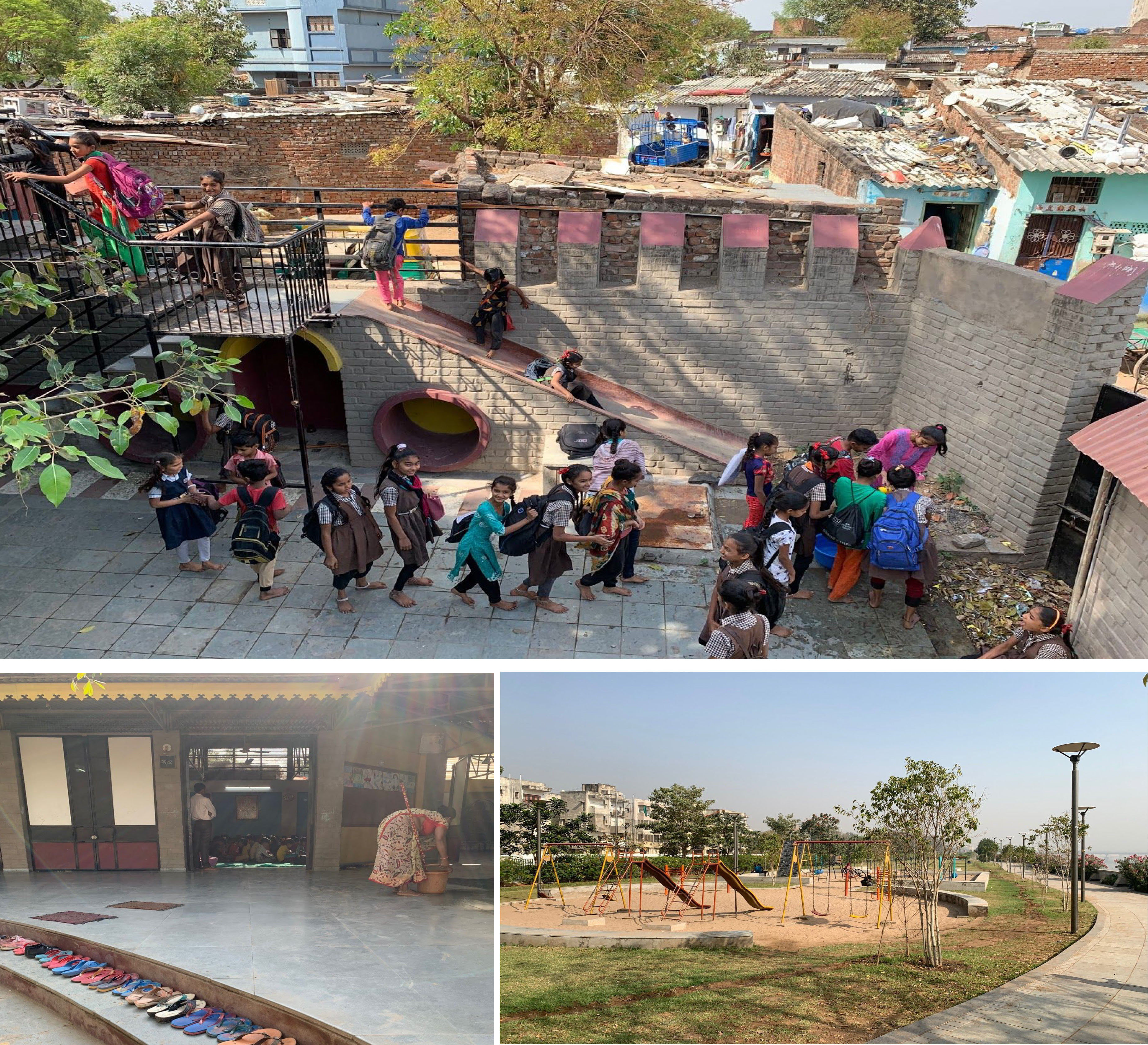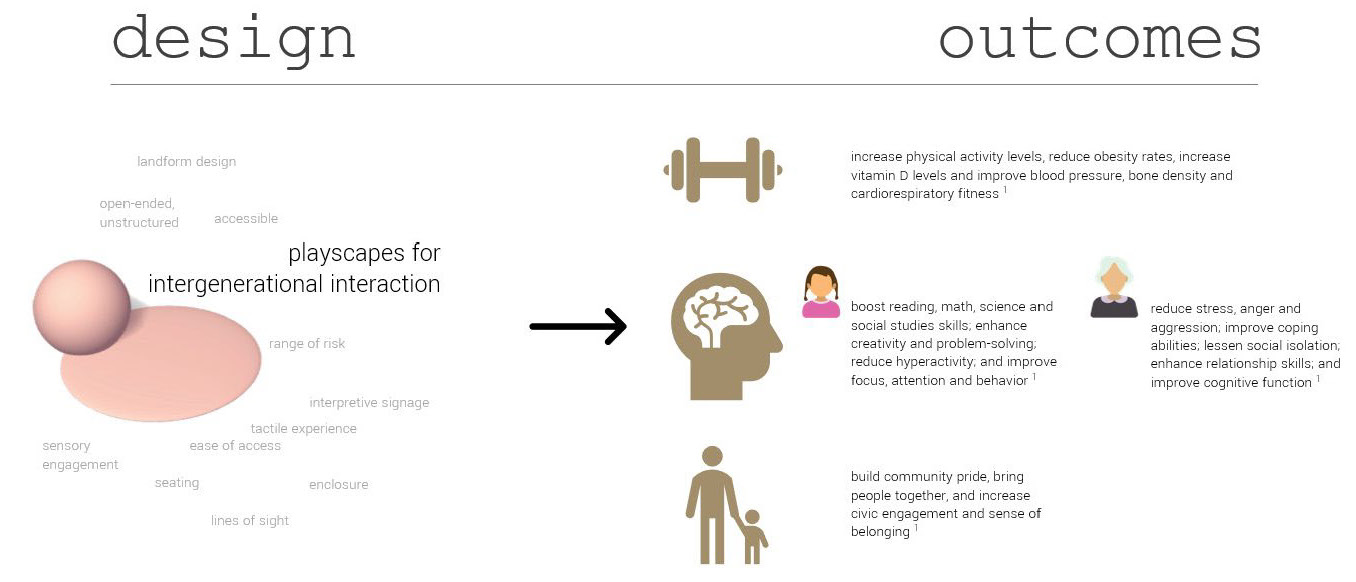︎ Play_grounds
Space-making for intergenerational play to improve social, mental, and physical well-being.
By Jamie Wiberg ︎

For the first time in recorded history, the number of people older than 65 years old surpassed the number of children under 5 years old in 2018 (World Health Organization WHO, 2020). Countries around the world have been going through an important demographic transition: from young to increasingly ageing populations. My project proposes that the role of intergenerational playgrounds and parks is critical for societal adaptation and health of aging cities.
Seniors are the most underrepresented groups using public parks (Loukaitou-Sideris et al, n.d.). My project primarily interjects on the architectural scale of the design continuum to provoke evidence-based designs for intergenerational playgrounds.
Hypothesis
By creating spaces for intergenerational interaction to occur in playful environments, it will increase the physical, mental, and social stimulation of all ages, thus improving overall health and wellbeing.

Qualitative Observations: Everyday activities of the elderly in India include sleeping, household chores, feeding animals, and economic livelihood. Notice that many of these activities are strenuous and taxing on the body.
Since the beginning of recorded history, young children have outnumbered their elders (65 years or older) as a percentage of the global population (Figure 1). With technological and medical advancements, life expectancies are continually increasing in the United States and throughout the world. How do we design play in tandem with aging as these roles reverse?
Since parks’ locations, usually in nearby neighborhoods, are either free or low-cost to visitors, and are accessible, recognition of parks’ importance as settings for physical activities has increased among those with interest for encouraging health (Loukaitou-Sideris et al, n.d.). Play is fundamental to human development throughout our lives. Playgrounds offer a platform for play, but many people are unable to experience their opportunities and benefits due to their configurations.

Qualitative Observations: Everyday primary activities of children in India include attending school and spending time with their friends and family. Play can happen in everywhere and not at all where intended (at the playground).
Questions
The core question for research and literature review is: Do elders have different open space and physical activity needs relative to younger persons? This question targets the possibilities and feasibility of truly designing intergenerational playgrounds. Other questions under consideration were:
- How do children play? What are their needs?
- How do elderly play? What are their needs?
- What are the current challenges of the elderly and aging population in the city?
- What makes a successful intergenerational space?

Qualitative Observations: Elderly enjoying the sunrise at Kankaria lake.
Methodology
Research methods include literature reviews, case studies, and international qualitative observations. The qualitative observations of eldery and children were performed over the course of two weeks in Ahmedabad, India. Information has been collected with the help of Manav Sadhna Community Center, faculty and students at CEPT University, and Professor María Arquero de Alarcón from Taubman College, University of Michigan. While this project is interested in how we can better incorporate intergenerational design of playgrounds in the United States, observations in an international context helped in understanding similarities across cultures and varying socio-economic statuses.
Guidelines to Design for Intergenerational Play
Rather than prescribing definitive solutions, I focused on providing prompts for how to design intergenerational playscapes. If we start by identifying users' needs, from the elderly to children with range of ability, and find where their needs intersect, we would be designing with the most perspectives in mind. By categorizing and deconstructing elements of play into their basic forms, we can begin to reimagine their roles in providing both space for children and elderly to interact. These taxonomies are representative of conventional artifacts of the playground, designed as unstructured play. Unstructured play is a category of play that is open-ended and is critical to brain-development (American Society of Landscape Architects, n.d.).

Taxonomy of Play / 2020
Design to Outcomes
By finding common ground on ways to enjoy life amongst multiple generations in shared spaces, we can bridge the generational gap in knowledge and health. Stable interaction between generations will promote healthy relationships as well as improve individual’s health and wellbeing.
By designing the playground - a traditional typology intended for children - for all ages, it opens opportunities for exploration and engagement across all user groups, creating positive health outcomes. The conceptual frameworks developed for play, mental, physical, and social, can be implemented anywhere.

︎
Works Cited
Creating Public Parks and Public Spaces for People of All Ages. (n.d.). AARP. Retrieved from https://www.aarp.org/content/dam/aarp/livable-communities/livable-documents/documents-2018/Parks Guide-LR-091018-singles.pdf
Dey S, Nambiar D, Lakshmi JK, et al. Health of the Elderly in India: Challenges of Access and Affordability. In: National Research Council (US) Panel on Policy Research and Data Needs to Meet the Challenge of Aging in Asia; Smith JP, Majmundar M, editors. Aging in Asia: Findings From New and Emerging Data Initiatives. Washington (DC): National Academies Press (US); 2012. 15. https://www.ncbi.nlm.nih.gov/books/NBK109208/
Evidence-Based Design. (n.d.). The Center for Health Design. Retrieved March 2020, from https://www.healthdesign.org/certification-outreach/edac/about
Facts about ageing. World Health Organization (WHO) (2015, October 3). Retrieved March 2020, from https://www.who.int/ageing/about/facts/en/
Gopnik, A. (2016, August 12). Playing Is More Than Fun-It's Smart. Retrieved from https://www.theatlantic.com/education/archive/2016/08/in-defense-of-play/495545/
Ibrahim, Dr. Andrew. Visiting Lecturer from HOK Dept. of Medicine. University of Michigan, Taubman College of Architecture and Urban Planning. 2020.
Loukaitou-Sideris, A., Levy-Storms, L., & Brozen, M. (n.d.). Placemaking for an Aging Population. Retrieved March 2020, from https://www.lewis.ucla.edu/wp-content/uploads/sites/2/2015/04/Seniors-and-Parks-8-28-Print_reduced.pdf
National Institute on Aging, National Institutes of Health, U.S. Department of Health and Human Services, & World Health Organization. (2011, October). Global Health and Aging. Retrieved March 2020, from https://www.who.int/ageing/publications/global_health.pdf
Site visit to Ahmedabad, Gujarat, India. March 1 - March 13, 2020. Information has been collected with the help of Manav Sadhna Community Center, faculty and students at CEPT University, and Professor Maria Alquero de Alarcon from Taubman College, University of Michigan.
Universal Design: Playgrounds. (n.d.). American Society of Landscape Architects. Retrieved from https://www.asla.org/universalplaygrounds.aspx
Upali, Dr. Nanda. ARCH 509: Health By Design Lecture. University of Michigan, Taubman College of Architecture and Urban Planning. 2020.
Wagoner, C. van. (2019, July 7). Parks as Infrastructure. Retrieved from https://cityparksalliance.org/resource/parks-as-infrastructure/